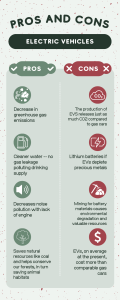
Mrs. Rieth’s AP Environmental Science class recently had the opportunity to explore a Tesla and dive into discussions on the environmental impact of electric vehicles. The class, which centers around environmentally conscious decision making and topics about renewable energy resources, weighed the benefits and potential negatives of electric vehicles.
Students Erin and Caitlin Johns shared their Tesla with the class, who observed all of the features atypical to the standard gas car. The lack of noise, along with the increased trunk room in both the front and rear of the car due to the lack of a large engine, were aspects that stood out to the class. Both of these factors are at the forefront of a much larger conversation concerning the pros and cons of electric vehicle usage.
There are many positives to electric vehicles, some quite significant. Green cars create minimal direct pollution to the environment in their operation. The air is left untouched, as there are no greenhouse gasses emitted from the tailpipe (as there isn’t one), any leaking gasoline won’t find its way to the water, and noise pollution is significantly reduced due to the lack of an engine. The comparison of emissions between gas and electric vehicles supports this claim: the Chevrolet Bolt EV emits 189 grams of CO2 for every mile (based on the emission from produced electricity to power the vehicle), the Toyota Camry 385 grams, and the Ford F-150 truck with a whopping 636 grams.
Yet as many opponents of electric vehicles would strongly suggest, there are negative environmental impacts. The production of the actual electric vehicle is very comparable to that of gas cars: both emit lots of CO2 and many metals are required to make the car, or which requires mining. As for charging, the majority of electricity generated in the United States is from fossil fuel sources such as natural gas, coal, and oil. Using fossil fuel to generate electricity for electric vehicles means that they are not entirely emission free.
As student Ember Bates noted, the advantages of electric vehicles are clear, and she predicts that “whether you want to or not, one day, you are going to be driving an electric car.” Companies such as Jeep, Ford, and Subaru have all adopted the electric model, with many citing a date of 2035 as a reasonable deadline for a massive shift to electric.
To Mrs. Rieth, one of the most valuable qualities lies in the electric vehicles’ quietness, a testament to the importance of noise pollution. “The reason I took the time for the students to see the tesla was not to see the model — everyone has seen a tesla at some point — it was to see the noise. You don’t realize it. Noise pollution can be a problem for hearing, and for mini ecosystems.” The push from the environmentally conscious community, as well as the scientific community despite any potential drawbacks, is clear, and the verdict is in favor of the adoption of EVs.
The shift is already happening; according to New York State records, there are 1.9 million passenger vehicles registered in New York City, of which nearly 2 percent are currently electric. Overall, EV adoption has been steadily increasing, with EV registrations increasing 44 percent between 2021 and 2022.
Hendrick Hudson’s AP Environmental class is ahead of the curve when it comes to understanding the science behind a potential innovation that could change the future of the environment. The implementation of electric vehicles serves as a green solution, but faces certain environmental challenges that have yet to be addressed.








